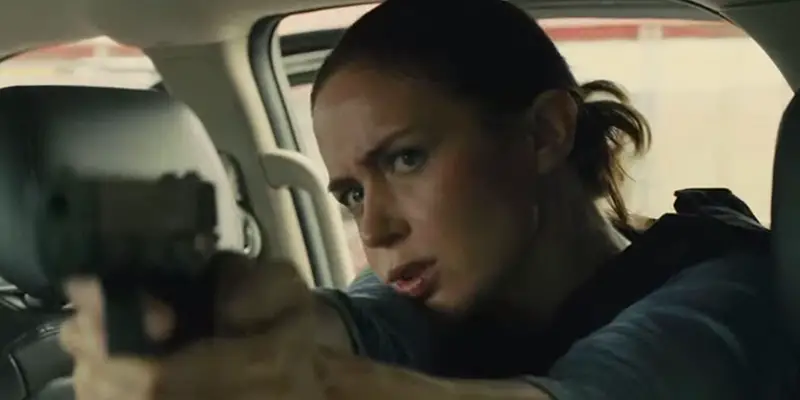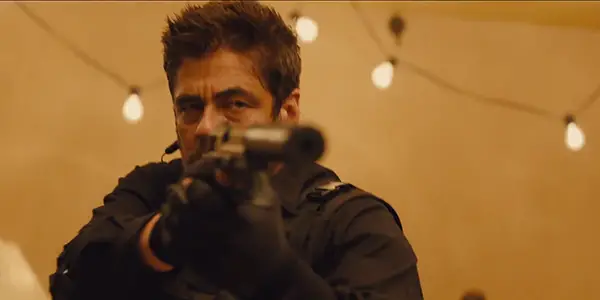SICARIO: A Veritable Magnum Opus

A bi-product of passion and experimentation gone wrong, Mike has…
“Your American ears won’t understand, your eyes will see things that make no sense, but in the end you’ll understand,” DOD Operative Alejandro (Benico Del Toro)
Brazen sunlight beats down on the terrain, voiding any visible shadows. Homes and domiciles of the Phoenix desert fill and occupy the frame, and the camera remains momentarily stationary. But then, in an instant, the machinery that captures and reproduces light stirs and begins to pan from right to left across the suburban community; as human beings, FBI agents in full riot gear with guns pointed, to be precise, enter into the picture. There’s pulsating music-as-sound-design that forces unease and nervous anticipation. Almost immediately, within a matter of seconds, the harsh world that appeared barren is saturated in legalism and the common acceptability of visible authority. Illumination, landscape, humankind, boundaries, law. This is the ironically dark world of Sicario, and the geography of how people fit in it and divide it with invisible lines.
Here Come The Fuzz
Kate Macer (Emily Blunt) is an idealistic FBI Special Weapons and Tactical Teams agent, who joins an elite task force fighting the drug war in America near Mexico’s borders. Headed by Matt Graver (Josh Brolin), and aided by the mysterious Alejandro, Kate quickly learns that the rules of engagement are merely to save political face and give the appearance of ethical and moral dealings. Once she passes through the looking-glass, Kate is taken aback by the actions that Matt and Alejandro take and can’t fathom or reconcile their reasons. The result is constant tension and white-knuckle thrills, making for one of the best films of the year.
Director Denis Villeneuve (Prisoners, Enemy) is our contemporary Alfred Hitchc*ck, who on the surface creates immaculately crafted features, but if one dares to gaze deeper you can find all manners of philosophical, existential, cerebral and religious quandaries. Villeneuve’s handling of each frame, shot and composition intensifies the dread of violence transpiring externally and internally in states of unrest. The world he creates in Sicario is purposefully tangible, thanks in part to the beautiful lighting of director of photography Roger Deakins (who will probably, once again, get shafted come awards season).

The film is utterly gorgeous and mesmerizing. One can’t simply extract the “beauty” of the picture without acknowledging its place in it. Martin Scorsese stated it perfectly: “Cinema is a matter of what’s in the frame and what’s out.” The work of Deakins and Villeneuve can’t be separated from the characters and plot, as similarly they can’t be removed from the piercing eye of the camera lens and the edits. How the images impact one another and expand from the very first shot is paramount in every film, and with Sicario there’s a perfect usage of space and timing. There’s breathing room when there needs to be, and there are smart cutaways during the heightened action set-pieces. Villeneuve plunges Kate, a surrogate stand-in proxy for the audience, into dangerous situations for the purose of expanding her paradigms. The meta-narrative comparison to the audience is the knowledge she acquires about life and the broken rules that supposedly govern it. However violent and ghastly the outcome is, there is a truthful caveat.
Corporeal Tendencies
Sicario opens on the ground and there are several of shots throughout the film of planes flying across the desert, but the focus is on the earth. One of the other first shots is of dust floating in air, material fabric which Kate stares at about halfway through the movie. The motif questions where human beings come from and ponders how we arrive at the final destination. Vehemently with murder, Sicario professes.
There’s a subplot to the film that is interwoven in the structure to help break up the main storyline. Once the subplot and the main narrative come together, it creates a vacuum between nations, cultures, sexes and generations. When the violence comes, it tears at the body with appall, perhaps making Sicario a horror film and less like an actioner that romanticizes brutality.

How a society reacts to terror and nihilistic acts of violence is the subject of many films and artwork. Sicario takes the bleakest stance on the matter yet. The movie fully believes that the rules written by modern civilizations are a cover-up for the similar acts of retribution. The attempt to correct the wrongs ostensibly escalates the problem. Villeneuve foresees the inevitable collapse of Western society as a result of hypocrisy and corrupted human nature. Violence begets violence and death begets death. It’s a vicious cycle with no endgame. The darkness of having one’s eyes opened is the reality of mortality, and scanning the dour horizon with clear vision is costly. One has to sign away their well being.
Summation
Sicario is a one-of-a-kind experience. It’s an action-drama that relishes its necessary job, but does so in unbelievable style. It’s not about living in today’s world, but about the consequences of adhering to universal hatred. It’s a trite aphorism but it can’t be said enough – we need to love. The only way to fix the world is to be selfless and give ourselves over to kindness and compassion. Or we are doomed to leave the future with a wasteland of terror from the outermost edges.
What is your favorite thriller? Does it have to be loaded with subtext or just straightforward entertainment?
(top image source: Lionsgate)
Does content like this matter to you?
Become a Member and support film journalism. Unlock access to all of Film Inquiry`s great articles. Join a community of like-minded readers who are passionate about cinema - get access to our private members Network, give back to independent filmmakers, and more.
A bi-product of passion and experimentation gone wrong, Mike has spent most of his time in the field couch surfing and growing a comb-over. Several of his favorite films are Rashomon, Vertigo, Apocalypse Now, and The Naked Gun.













